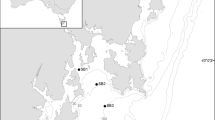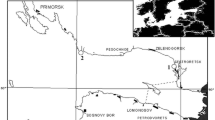Abstract
We studied the gut contents of Gammarus lacustris from the littoral of Shira lake, a Siberian salt lake, by microscopic analysis in conjunction with measuring of fluorescence of chlorophyll and composition of fatty acids. Gammarus ingested primarily fresh seston, probably settled on the bottom. Additionally, the amphipods obtained essential polyunsaturated fatty acids of ω3 family by selectively consuming bottom sediment particles. A considerable part of the ingested seston comprised cells of Botryococcus sp., which passed the intestinal tract in living form and their photosynthetic activity increased. This viable gut passage was likely one of the causes of bloom of Botryococcusin the littoral. Unlike a number of literature data, there was no selective digestion of any fatty acid species, including polyunsaturated acids, in the intestinal tract.
Similar content being viewed by others
References
Bligh, E. G. &; W. J. Dyer, 1959. A rapid method of total lipid extraction and purification. Can. J. Biochem. 37: 911–917.
Campbell, R. C., 1967. Statistics for Biologists. University Press, Cambridge: 242 pp.
Canuel, E. A., J. E. Cloern, D. B. Ringelberg &; J. B. Guckert, 1995. Molecular and isotopic tracers used to examine sources of organic matter and its incorporation into food webs of San Francisco Bay. Limnol. Oceanogr. 40: 67–81.
Clarke, A., L. J. Holmes, &; C. C. E. Hopkins, 1987. Lipids in Arctic food chain: Calanus, Bolinopsis, Beroe. Sarsia 72: 41–48.
Clarke, A., A. Skadsheim &; L. J. Holmes, 1985. Lipid biochemistry and reproductive biology in two species of Gammaridae (Crustacea: Amphipoda). Mar. Biol. 88: 247–263.
Claustre, H., J. C. Marty, L. Cassiani &; J. Dagaut, 1988/89. Fatty acid dynamics in phytoplankton and microzooplankton communnities during a spring bloom in the coastal Ligurian Sea: ecological implications. Mar. Microbial. Food Webs 3: 51–66.
Claustre, H., S. A. Poulet, R. Williams, F. Ben-Mlih, V. Martin-Jezequel &; J. C. Marty, 1992. Relationship between the qualitative nature of particles and copepod faeces in the Irish Sea. Mar. Chem. 40: 231–248.
Ederington, M., G. B. McManus &; R. Harvey, 1995. Trophic transfer of fatty acids, sterols and a triterpenoid alcohol between bacteria, a ciliate, and the copepod Acartia tonsa. Limnol. Oceanogr. 40: 860–867.
Gayte, X. &; D. Fontvieille, 1997. Autochthonous vs. allochthonous organic matter ingested by a macroinvertebrate in headwater streams: Gammarus sp. as a biological probe. Arch. Hydrobiol. 140: 23–36.
Goulden, C. E. &; A. R. Place, 1990. Fatty acid synthesis and accumulation rates in daphnids. J. Exp. Zool. 256: 168–178.
Jefers J., 1981. An introduction to system analysis: with ecological application. 'Mir', Moscow: 252 pp. (translated from English).
Keller, A. A., 1987. Mesocosm studies of DCMU-enhanced fluorescence as a measure of phytoplankton photosynthesis. Mar. Biol. 96: 107–114.
Knisley, K. &; W. Geller, 1986. Selective feeding of four zooplankton species on natural lake phytoplankton. Oekologia. 69: 86–94.
Kuzmin, G. V., 1975. Species composition and abundance of phytoplankton. In Mordukhai-Boltovskoi, F. D. (ed.), Methods for Investigation of Inland Aquatic Biogeocenoses. Nauka, Moscow: 73–87 (in Russian).
Muller-Navarra, D., 1995. Evidence that a highly unsaturated fatty acid limits Daphnia growth in nature. Arch. Hydrobiol. 132: 297–307.
Napolitano, G. E. &; R. G. Ackman, 1989. Lipids and hydrocarbons in Corophium volutator from Minas Basin, Nova Scotia. Mar. Biol. 100: 333–338.
Nichols, P. D., J. K. Volkman &; D. A. Everitt, 1989. Occurrence of cis-6-hexadecenoic acid and other unusual monounsaturated fatty acids in the lipids of oceanic particulate matter. Ocean. Acta. 12: 393–403.
Porter, K. G., 1976. Enhancement of algal growth and productivity by grazing zooplankton. Science 192: 1332–1336.
Quigley, M. A. &; H. A. Vanderploeg, 1991. Ingestion of live filamentous diatoms by the Great Lakes amphipod Diporea sp.: A case study of the limited value of gut contents analysis. Hydrobiologia 223 (Dev. Hydrobiol. 30): 141–148.
Rights and permissions
About this article
Cite this article
Gladyshev, M.I., Emelianova, A.Y., Kalachova, G.S. et al. Gut content analysis of Gammarus lacustris from a Siberian lake using biochemical and biophysical methods. Hydrobiologia 431, 155–163 (2000). https://doi.org/10.1023/A:1004036111433
Issue Date:
DOI: https://doi.org/10.1023/A:1004036111433




